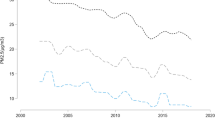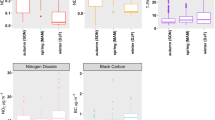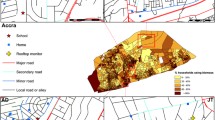Abstract
OBJECTIVES: We aimed to assess the relationships between deprivation at Quebec public schools, their proximity to polluting industries, and their exposure to industrial air emission sources including ambient fine particulate matter (PM2.5), sulphur dioxide (SO2) and nitrogen dioxide (NO2).
METHODS: We obtained four indicators of school deprivation using data from the 2006 Canadian census called the low-income threshold indicator, the neighbourhood SES indicator, and the social and material deprivation indicators of Pampalon. Using proximity spatial tools, we constructed three buffers of 2.5, 5 and 7.5 km around each school and summed up total emissions of PM2.5, SO2 and NO2 for each school. Industrial air emissions were estimated using data from the 2006 Canadian National Pollutant Release Inventory. The Pearson correlations and LOESS regressions and natural log-transformed industrial air emissions were evaluated for Quebec public schools within the three buffers.
RESULTS: Of the 2189 public schools in Quebec, 608 (27.8%), 1108 (50.6%) and 1384 (63.2%) schools were located near at least one industry emitting one or more pollutants of interest in buffers of 2.5 km, 5 km and 7.5 km of schools respectively. Weak positive Pearson correlations (r) were found between log-transformed tons of industrial emissions of PM2.5, SO2 and NO2 and both the social deprivation (r = {0.23; 0.33}) and low-income threshold (r = {0.17; 0.29}) indicators in a buffer of 2.5 km. However, we found negative associations between emissions and the neighbourhood SES (r = {0.06; 0.16}) and material deprivation (r = {−0.04; 0.08}) indicators.
CONCLUSION: Our study suggests that schools in Quebec with higher rates of socio-economic deprivation among their students may be more likely to be exposed to higher emissions of industrial air pollutants.
Résumé
OBJECTIFS: L’objectif de cette étude était d’explorer la relation entre le niveau de défavorisation des écoles publiques québécoises, leur proximité aux sources industrielles et leur exposition aux émissions industrielles de particules fines (PM2.5), de dioxyde de soufre (S02) et d’oxydes d’azote (NOx).
MÉTHODES: L’indice de faible revenu (SFR), l’indice de milieu socio-économique (IMSE) et les indices de défavorisation sociale et matérielle de Pampalon, basés sur le recensement de 2006, ont été utilisés. Des cercles de rayons de 2,5 km, 5 km et 7,5 km ont été construits autour des écoles. En utilisant l’Inventaire national de rejets de polluants, les émissions industrielles de PM2.5, SO2 et NO2 de l’année 2006 ont été sommées dans chaque rayon. Les relations entre les émissions industrielles log-transformées et la défavorisation ont été évaluées pour les écoles en utilisant des corrélations de Pearson et des régressions LOESS.
RÉSULTATS: Des 2189 écoles incluses dans cette étude, 608 (27,8 %), 1108 (50,6 %) et 1 384 (63,2 %) étaient localisées à proximité d’au moins une industrie émettrice d’un ou plusieurs polluants d’intérêt dans un rayon de 2,5 km, 5 km et 7,5 km autour des écoles, respectivement. Des corrélations de Pearson (r) positives ont été notées entre les tonnes d’émissions industrielles log-transformées de PM2.5, SO2 et NO2 et l’indice de défavorisation sociale de Pampalon (r = {0,23; 0,33}) et le SFR (r = {0,17; 0,29}) dans un rayon de 2.5 km. Cependant des corrélations contre-intuitives ont été observées avec l’IMSE (r = {0,06; 0,16}) et l’indice de défavorisation matérielle de Pampalon (r = {−0,04; 0,08}).
CONCLUSION: Cette étude suggère que les écoles québécoises plus défavorisées pourraient être davantage exposées aux émissions industrielles de polluants de l’air que les autres.
Similar content being viewed by others
References
U.S. EPA. 2008 Final Report: Integrated Science Assessment (ISA) for Sulfur Oxides -Health Criteria. Washington, DC: U.S. Environmental Protection Agency, EPA/600/R-08/047F, 2008.
U.S. EPA. 2009 Final Report: Integrated Science Assessment for Particulate Matter. Washington, DC: U.S. Environmental Protection Agency, EPA/600/R-08/139F, 2009.
U.S. EPA. Integrated Science Assessment for Oxides of Nitrogen - Health Criteria (2016 Final Report). Washington, DC: U.S. Environmental Protection Agency, EPA/600/R-15/068, 2016.
Bateson TF, Schwartz J. Children’s response to air pollutants. J Toxicol Environ Health 2008;71(3):238–43. PMID: 18097949. doi: 10.1080/15287390 701598234.
Clark-Reyna SE, Grineski SE, Collins TW. Residential exposure to air toxics is linked to lower grade point averages among school children in El Paso, Texas, USA. Popul Environ 2015;37(3):319–40. PMID: 27034529. doi: 10.1007/s11111-015-0241-8.
Cesaroni G, Badaloni C, Romano V, Donato E, Perucci CA, Forastiere F. Socioeconomic position and health status of people who live near busy roads: The Rome Longitudinal Study (RoLS). Environ Health 2010;9:41. PMID: 20663144. doi: 10.1186/1476-069X-9-41.
Green RS, Smorodinsky S, Kim JJ, McLaughlin R, Ostro B. Proximity of California public schools to busy roads. Environ Health Perspect 2004; 112(1):61–66. PMID: 14698932. doi: 10.1289/ehp.6566.
Perlin SA, Wong D, Sexton K. Residential proximity to industrial sources of air pollution: Interrelationships among race, poverty, and age. J Air Waste Manage Assoc 2001;51(3):406–21. PMID: 11266104. doi: 10.1080/10473289. 2001.10464271.
Chakraborty J, Zandbergen PA. Children at risk: Measuring racial/ethnic disparities in potential exposure to air pollution at school and home. J Epidemiol Community Health 2007;61(12):1074–79. PMID: 18000130. doi: 10. 1136/jech.2006.054130.
Bell ML, Ebisu K. Environmental inequality in exposures to airborne particulate matter components in the United States. Environ Health Perspect 2012;120(12):1699–704. PMID: 22889745. doi: 10.1289/ehp.l205201.
Chaix B, Gustafsson S, Jerrett M, Kristersson H, Lithman T, Boalt Å, et al. Children’s exposure to nitrogen dioxide in Sweden: Investigating environmental injustice in an egalitarian country. J Epidemiol Community Health 2006;60(3):234–41. PMID: 16476754. doi: 10.1136/jech.2005.038190.
Carrier M, Apparicio P, Séguin A-M, Crouse D. Ambient air pollution concentration in Montreal and environmental equity: Are children at risk at school? Case Stud Transp Policy 2014;2:61–69. doi: 10.1016/j.cstp.2014.06. 003.
Pinault L, Crouse D, Jerrett M, Brauer M, Tjepkema M. Socioeconomic differences in nitrogen dioxide ambient air pollution exposure among children in the three largest Canadian cities. Health Rep 2016;27:3–9. PMID: 27438998.
Gouvernement du Québec. Chapitre I-13.3, r.8 Régime pédagogique de l’éducation préscolaire, de l’enseignement primaire et de l’enseignement secondaire: Loi sur l’instruction publique. Quebec, 2016. Available at: http://legisquebec.gouv.qc.ca/fr/showdoc/cr/I-13.3%20r.%208 (Accessed September 1, 2016).
Wheeler BW, Ben-Shlomo Y. Environmental equity, air quality, socioeconomic status, and respiratory health: A linkage analysis of routine data from the Health Survey for England. J Epidemiol Community Health 2005; 59(11):948–54. PMID: 16234422. doi: 10.1136/jech.2005.036418.
Brand A, McLean KE, Henderson SB, Fournier M, Liu L, Kosatsky T, et al. Respiratory hospital admissions in young children living near metal smelters, pulp mills and oil refineries in two Canadian provinces. Environ Int 2016; 94:24–32. PMID: 27203781. doi: 10.1016/j.envint.2016.05.002.
Ministère de l’Education de l’Enseignement Supérieur et de la Recherche du Québec. Indices de défavorisation. Québec, QC: Gouvernement du Québec, 2017. Available at: http://www.education.gouv.qc.ca/references/statistiques/indicateurs-de-leducation/indices-de-defavorisation/ (Accessed May 1, 2017).
Pampaion R, Gamache P, Hamel D. Indice de défavorisation matérielle et sociale du Québec. Suivi méthodologique de 1991 à 2006. Québec, QC: Institut national de santé publique du Québec (INSPQ), 2010.
Ministère de l’Education de l’Enseignement Supérieur et de la Recherche du Québec. Indices de défavorisation par école 2013–2014. Québec, QC: Gouvernement du Québec, 2014.
Ibrahima M, Lavoie S, Riberdy H, Zanfongnon R. Comparaison entre l’indice de défavorisation des écoles CGTSIM et ceux du MELS. Québec, QC: Agence de la santé et des services sociaux de Montréal, 2014.
Baillargeon G. La carte des unités de peuplement de 2003. Les principales données socio-économiques et démographiques du recensement de 2001 selon les territoires des commissions scolaires. Québec, QC: Ministère de l’Education du Loisir et du Sport, Direction de la recherche des statistiques et des indicateurs, 2005.
Statistics Canada. Dissemination Area (DA). Ottawa, 2015. Available at: https://wwwl2.statcan.gc.cahttps://wwwl2.statcan.gc.ca/census-recensement/2011/ref/dict/geo021-eng.cfm (Accessed May 1, 2016).
Environment and Climate Change Canada. Air Pollutant Emission Inventory Report 1990–2014. Ottawa, 2016. Available at: http://www.ec.gc.ca/pollution/default.asp?lang=En&n=E96450C4-l (Accessed October 1, 2016).
Lewin A, Buteau S, Brand A, Kosatsky T, Smargiassi A. Short-term risk of hospitalization for asthma or bronchiolitis in children living near an aluminum smelter. J Expo Sci Environ Epidemiol 2013;23:474–80. PMID: 23695491. doi: 10.1038/jes.2013.27.
Smargiassi A, Kosatsky T, Hicks J, Plante C, Armstrong B, Villeneuve PJ. Risk of asthmatic episodes in children exposed to sulfur dioxide stack emissions from a refinery point source in Montreal, Canada. Environ Health Perspect 2009; 117(4):653–59. PMID: 19440507. doi: 10.1289/ehp.0800010.
Gunier RB, Hertz A, von Behren J, Reynolds P. Traffic density in California: Socioeconomic and ethnic differences among potentially exposed children. J Expo Anal Environ Epidemiol 2003;13(3):240–46. PMID: 12743618. doi: 10. 1038/sj.jea.7500276.
Fan X, Lam K-C, Yu Q Differential exposure of the urban population to vehicular air pollution in Hong Kong. Sci Total Environ 2012;426:211–19. PMID: 22542227. doi: 10.1016/j.scitotenv.2012.03.057.
Stuart AL, Zeager M. An inequality study of ambient nitrogen dioxide and traffic levels near elementary schools in the Tampa area. J Environ Manage 2011;92(8):1923–30. PMID: 21497986. doi: 10.1016/j.jenvman.2011.03.003.
Chan E, Serrano J, Chen L, Stieb DM, Jerrett M, Osornio-Vargas A. Development of a Canadian socioeconomic status index for the study of health outcomes related to environmental pollution. BMC Public Health 2015; 15:714–22. PMID: 26215141. doi: 10.1186/sl2889-015-1992-y.
Miranda ML, Edwards SE, Keating MH, Paul CJ. Making the environmental justice grade: The relative burden of air pollution exposure in the United States. Int J Environ Res Public Health 2011;8(6):1755–71. PMID: 21776200. doi: 10.3390/ijerph8061755.
Fecht D, Fischer P, Fortunato L, Hoek G, de Hoogh K, Marra M, et al. Associations between air pollution and socioeconomic characteristics, ethnicity and age profile of neighbourhoods in England and the Netherlands. Environ Pollut 2015;198:201–210. PMID: 25622242. doi: 10. 1016/j.envpol.2014.12.014.
Environment and Climate Change Canada. Summary of National Pollutant Release Inventory Reporting requirements. Government of Canada, 2016. Available at: https://www.ec.gc.ca/inrp-npri/default.asp?lang=En&n=629573FE-1 (Accessed May 1, 2016).
Zhou Y, Levy JI. Factors influencing the spatial extent of mobile source air pollution impacts: A meta-analysis. BMC Public Health 2007;7:89. PMID: 17519039. doi: 10.1186/1471-2458-7-89.
Author information
Authors and Affiliations
Corresponding author
Additional information
Conflict of Interest: None to declare.
Rights and permissions
About this article
Cite this article
Batisse, E., Goudreau, S., Baumgartner, J. et al. Socio-economic inequalities in exposure to industrial air pollution emissions in Quebec public schools. Can J Public Health 108, e503–e509 (2017). https://doi.org/10.17269/CJPH.108.6166
Received:
Accepted:
Published:
Issue Date:
DOI: https://doi.org/10.17269/CJPH.108.6166




